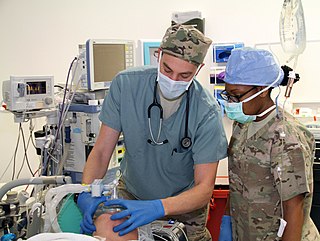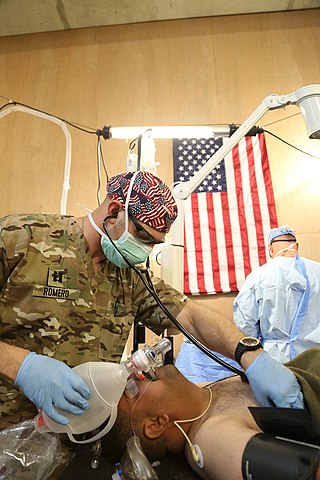Related Research Articles

Anesthesia or anaesthesia is a state of controlled, temporary loss of sensation or awareness that is induced for medical or veterinary purposes. It may include some or all of analgesia, paralysis, amnesia, and unconsciousness. An individual under the effects of anesthetic drugs is referred to as being anesthetized.

General anaesthesia (UK) or general anesthesia (US) is a method of medically inducing loss of consciousness that renders a patient unarousable even with painful stimuli. This effect is achieved by administering either intravenous or inhalational general anaesthetic medications, which often act in combination with an analgesic and neuromuscular blocking agent. Spontaneous ventilation is often inadequate during the procedure and intervention is often necessary to protect the airway. General anaesthesia is generally performed in an operating theater to allow surgical procedures that would otherwise be intolerably painful for a patient, or in an intensive care unit or emergency department to facilitate endotracheal intubation and mechanical ventilation in critically ill patients. Depending on the procedure, general anaesthesia may be optional or required. Regardless of whether a patient may prefer to be unconscious or not, certain pain stimuli could result in involuntary responses from the patient that may make an operation extremely difficult. Thus, for many procedures, general anaesthesia is required from a practical perspective.

Anesthesiology, anaesthesiology or anaesthesia is the medical specialty concerned with the total perioperative care of patients before, during and after surgery. It encompasses anesthesia, intensive care medicine, critical emergency medicine, and pain medicine. A physician specialized in anesthesiology is called an anesthesiologist, anaesthesiologist, or anaesthetist, depending on the country. In some countries, the terms are synonymous, while in other countries, they refer to different positions and anesthetist is only used for non-physicians, such as nurse anesthetists.
Awareness under anesthesia, also referred to as intraoperative awareness or accidental awareness during general anesthesia (AAGA), is a rare complication of general anesthesia where patients regain varying levels of consciousness during their surgical procedures. While anesthesia awareness is possible without resulting in any long-term memory of the experience, it is also possible for victims to have awareness with explicit recall, where they can remember the events related to their surgery.

A nurse anesthetist is an advanced practice nurse who administers anesthesia for surgery or other medical procedures. They are involved in the administration of anesthesia in a majority of countries, with varying levels of autonomy. Nurse anesthetists provide all services of anesthesia for patients before, during, and after surgery. Certified Registered Nurse Anesthetists, (CRNA) are dedicated to the safe administration of anesthesia delivery and work within a diverse team. They are dedicated to patient advocacy, safety and professional development. In some localities, nurse anesthetists provide anesthesia to patients independently; in others they do so under the supervision of physicians. In the United States, the physician may be an anesthesiologist, surgeon, or podiatrist. The International Federation of Nurse Anesthetists was established in 1989 as a forum for developing standards of education, practice, and a code of ethics.

A Certified Registered Nurse Anesthetist (CRNA) is a type of advanced practice nurse who administers anesthesia in the United States. CRNAs account for approximately half of the anesthesia providers in the United States and are the main providers (80%) of anesthesia in rural America. Historically, nurses have been providing anesthesia care to patients for over 160 years, dating back to the American Civil War (1861–1865). The CRNA credential was formally established in 1956. CRNA schools issue a Doctorate of nursing anesthesia degree to nurses who have completed a program in anesthesia, which is 3 years in length.
Perioperative mortality has been defined as any death, regardless of cause, occurring within 30 days after surgery in or out of the hospital. Globally, 4.2 million people are estimated to die within 30 days of surgery each year. An important consideration in the decision to perform any surgical procedure is to weigh the benefits against the risks. Anesthesiologists and surgeons employ various methods in assessing whether a patient is in optimal condition from a medical standpoint prior to undertaking surgery, and various statistical tools are available. ASA score is the most well known of these.
The American Society of Anesthesiologists (ASA) is a professional association of physicians in the field of anesthesiology.
The ASA physical status classification system is a system for assessing the fitness of patients before surgery. In 1963 the American Society of Anesthesiologists (ASA) adopted the five-category physical status classification system; a sixth category was later added. These are:
- Healthy person.
- Mild systemic disease.
- Severe systemic disease.
- Severe systemic disease that is a constant threat to life.
- A moribund person who is not expected to survive without the operation.
- A declared brain-dead person whose organs are being removed for donor purposes.
In the United States, anesthesia can be administered by physician anesthesiologists, an anesthesiologist assistant, or nurse anesthetist.
Cardiothoracic anesthesiology is a subspeciality of the medical practice of anesthesiology, devoted to the preoperative, intraoperative, and postoperative care of adult and pediatric patients undergoing cardiothoracic surgery and related invasive procedures.
Preoperative fasting is the practice of a surgical patient abstaining from eating or drinking for some time before having an operation. This is intended to prevent stomach contents from getting into the windpipe and lungs while the patient is under general anesthesia. The latest guidelines do not support preoperative fasting, as there is no difference in residual gastric fluid volume, pH or gastric emptying rate following semi-solid meals or drinks, whether in obese or lean individuals.
The American Association of Nurse Anesthesiology (AANA), previously named the American Association of Nurse Anesthetists, is a professional association for nurse anesthetists in the United States. The organization states that it has a membership of more than 62,000 and represents approximately 90% of CRNAs in the United States. The AANA headquarters is currently located in Rosemont, Illinois, a suburb of Chicago.
Neurosurgical anesthesiology, neuroanesthesiology, or neurological anesthesiology is a subspecialty of anesthesiology devoted to the total perioperative care of patients before, during, and after neurological surgeries, including surgeries of the central (CNS) and peripheral nervous systems (PNS). The field has undergone extensive development since the 1960s correlating with the ability to measure intracranial pressure (ICP), cerebral blood flow (CBF), and cerebral metabolic rate (CMR).
Certified anesthesiologist assistants (CAAs) are master’s degree level non-physician anesthesia care providers. CAAs are members of the anesthesia care team as described by the American Society of Anesthesiologists (ASA). This designation must be disambiguated from the Certified Clinical Anesthesia Assistant (CCAA) designation conferred by the Canadian Society of Respiratory Therapists. All CAAs possess a baccalaureate degree, and complete an intensive didactic and clinical program at a postgraduate level. CAAs are trained in the delivery and maintenance of most types of anesthesia care as well as advanced patient monitoring techniques. The goal of CAA education is to guide the transformation of student applicants into competent clinicians.
The following outline is provided as an overview of and topical guide to anesthesia:

Kathryn Ann Kelly "Kelly" McQueen is an American anesthesiologist and global health expert. She currently practices anesthesiology at the UW Health University Hospital in Madison, Wisconsin and serves as the chair for the Department of Anesthesiology at the University of Wisconsin School of Medicine and Public health.

Alex Bekker is a physician, author and academic. He is a professor and chair at the Department of Anesthesiology, Rutgers New Jersey Medical School. He is also professor at the Department of Physiology, Pharmacology & Neurosciences. He serves as the Chief of Anesthesiology Service at the University Hospital in Newark.
Alex Macario is an American anesthesiologist, academic and author. He is a vice-chair for education, a professor in the Department of Anesthesiology, Perioperative and Pain Medicine, and program director for the anesthesiology residency at Stanford University School of Medicine.
Calvin Johnson is an American anesthesiologist and professor of anesthesiology at Cedars-Sinai Medical Center in Los Angeles, California. Born and raised in Egelston Township, Muskegon, Michigan, Johnson attended Oakridge High School, where he excelled in multiple sports and was a first-team Associated Press all-state basketball player. He went on to play point guard at Dartmouth College, earning Academic All-American honors and ranked second for assists in the Ivy League during his senior year.
References
- ↑ "GERIATRIC ANESTHESIA by David J Cook" (PDF). Archived from the original (PDF) on 2006-05-30. Retrieved 2008-11-09.
- ↑ "Syllabus on Geriatric Anesthesiology, American Society of Anesthesiologists". Archived from the original on 2008-10-11. Retrieved 2008-11-09.
- ↑ "Useful Geriatric Anesthesiology Resources". Archived from the original on 2008-05-13. Retrieved 2008-11-09.
- ↑ "GERIATRIC ANESTHESIA by David J Cook" (PDF). Archived from the original (PDF) on 2006-05-30. Retrieved 2008-11-09.
- ↑ "Geriatric Anesthesiology Curriculum" (PDF). Archived from the original (PDF) on 2008-12-03. Retrieved 2008-11-09.
- ↑ "Geriatric Education: 'Start Low, Go Slow', ASA NEWSLETTER". Archived from the original on 2008-05-15. Retrieved 2008-11-09.
- ↑ "The Society for the Advancement of Geriatric Anesthesia (SAGA)". Archived from the original on 2012-06-28. Retrieved 2012-07-05.
- ↑ "Age Anaesthesia Society in the UK". Archived from the original on 2008-10-06. Retrieved 2008-11-18.